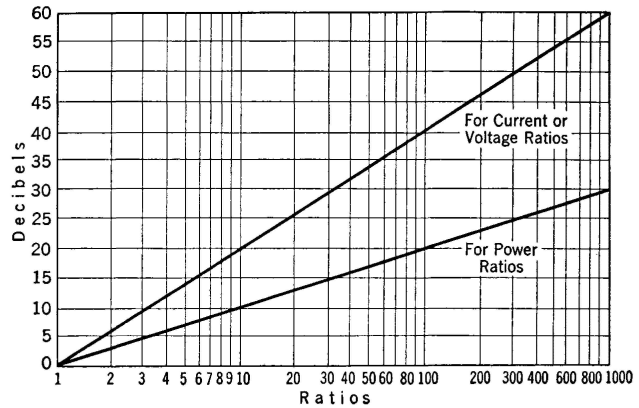| Electrical Communication is a free textbook on the basics of communication technology. See the editorial for more information.... |

|

Home  Electrical Fundamentals of Communication Electrical Fundamentals of Communication  The Decibel The Decibel |
||||||||||||||||||||||||||||||||||||||||||||||||||||||||||||||||||||||||||||||||||||||||||






|
||||||||||||||||||||||||||||||||||||||||||||||||||||||||||||||||||||||||||||||||||||||||||
The DecibelThe bel is defined1 as "the fundamental division of a logarithmic scale for expressing the ratio of two amounts of power, the number of bels denoting such a ratio being the logarithm to the base 10 of this ratio." If P1 and P2 designate two amounts of power, and if N is the number of bels denoting their ratio,
The decibel is defined1 as "one-tenth of a bel, the number of decibels denoting the ratio of two amounts of power being 10 times the logarithm to the base 10 of this ratio." The abbreviation db is used extensively. If P1 and P2 designate two amounts of power, and if n is the number of decibels denoting their ratio,
Power is seldom measured directly in communication circuits. It is usually determined indirectly from current measurements made with thermocouples, or from voltage measurements made with vacuum-tube voltmeters. Because of these indirect measurements of power, confusion has resulted in the use of the decibel, and the reasons will now be explained.
It is desired to determine the power loss in decibels of the network of Fig. 30. This is to be done from the ratio of the input current I1 and the output current I2. Since power is I2R, equation 49 can be written
If R1/R2 = 1.0, then the last term equals zero, and under these special conditions, in which the resistance components of the input impedance equals the resistance component of the load impedance, the power ratio and the loss in decibels is
Similarly, if the power loss is to be determined from voltage readings, where El is the voltage impressed across the network and E2 is the voltage across the load, since power = EI cosθ, equation 49 can be written
If it happens that Z1 equals Z2 in both magnitude and phase, then the last two terms become zero, and under these special conditions the power ratio and the loss in decibels is
The confusion mentioned previously resulted from using equations 51 and 53 to determine power ratios in decibels in circuits that were not matched and did not meet the special conditions explained. Most telephone lines and apparatus are matched for maximum power transfer, and thus the impedance relations are such that equations 51 and 52 can be used without error. However, many circuits and much equipment are not matched for maximum power transfer, and hence these equations do not apply. It is common practice to use equations 51 and 53 in circuits in which the impedances are not matched, but when so used these equations do not give power ratios in decibels but instead express current or voltage ratios in decibels. This is in accordance with the Standards,1 but the usage should be accompanied by a statement of the specific application. Gains in decibels as well as losses are expressed by equations 49, 51, and 53. In all instances the larger number is divided by the smaller, and the terminology "gain" or "loss" is used. Equations 49, 51, and 53 can be plotted as in Fig. 31. With these curves, the gain or loss in decibels can be found. Also, gains or losses can be determined from Table V.
TABLE V RELATIONS BETWEEN DECIBELS AND FRACTIONAL Loss OB GAIN IN POWER
Transmission losses are sometimes expressed in nepers. From equations 51 and 53, the loss in decibels is
If the natural or Napierian base for the logarithms is used,
where n' is the loss (or gain) in nepers. The relation between the natural and common logarithms is ln x = 2.3026 log10 x. Therefore, from equation 54, n' = 2.3026 log10 I1/I2. From equation 51, n/20 = log10I1/I2, and
|
||||||||||||||||||||||||||||||||||||||||||||||||||||||||||||||||||||||||||||||||||||||||||
Home  Electrical Fundamentals of Communication Electrical Fundamentals of Communication  The Decibel The Decibel |
||||||||||||||||||||||||||||||||||||||||||||||||||||||||||||||||||||||||||||||||||||||||||
Last Update: 2011-05-30












